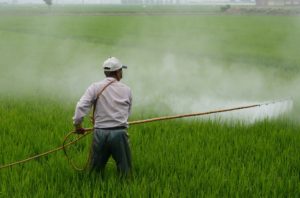This Guest Article for REVITALIZATION is written by Emily Folk.
Climate change is a conversation in government, business, education and within our own homes. Addressing such a daunting topic can seem challenging, though. Many believe technology is the answer to reducing fossil fuel consumption and addressing the climate crisis. However, scientists today are focusing on a natural solution to reversing the damage — regenerative agriculture.
While regenerative farming differs from traditional methods, the goal is the same — to transfer carbon from the atmosphere to the soil. As pressure increases to address climate change, some believe regenerative agriculture could upend the traditional farming industry and give our country hope for a bright future.
What Is Regenerative Agriculture?
Regenerative agriculture is an approach to farming that focuses on repairing soil degraded by industrial and agricultural use. It promotes holistic farming and grazing techniques, which in turn lead to healthier ecosystems through organic matter. Regenerative farming doesn’t involve tools or technology. Instead, the approach allows nature to do the work.
Why is soil so important to the health of the entire farming system? Soil organic matter, which makes up 2% to 10% of the earth, includes plant or animal tissue that’s decaying. Every time you increase the amount of soil organic matter by 1%, soil holds 20,000 more gallons of water per acre. That extra water gives crops the nutrients they need to survive through drought and heavy rains while decreasing nutrient runoff and erosion.
As your soil grows healthier, your crop benefits. Your plants will get more of the nutrients they need, building robust roots systems and naturally developing compounds to protect against insects and disease. Some research even shows these resilient crops are more nutrient-dense, leading to better human health.
Regenerative Agriculture Methods
While the purpose of regenerative agriculture is naturally revitalizing the soil, you can use a variety of methods to accomplish it. Some proven techniques include:
- Adding more livestock: Large animals break up the earth, which allows nutrients to get to new plants and creates a natural mulch. Livestock’s manure also adds nutrients to the ground, which helps plants grow and improves water retention;
- Keeping the soil covered: Using plant residues and cover crops protects your precious soil from wind and water erosion, keeps its temperature low and feeds microorganisms that want to grow;
- Limiting soil disturbance: Traditional farming methods focus on tilling, but disturbing the soil can impact the nutrient cycle and environmental resilience. Giving your soil space helps it stay structurally sound while preventing erosion; and,
- Diversify your crops: Whether it’s animals or plants, a diverse ecosystem will provide healthier and more resilient soil. Try to create an entire farm system that works with nature instead of against it, involving every creature on the land. Crop diversity is an essential element of the Sustainably Grown certification.
Are Pesticides Involved?
While most agree on the regenerative agriculture practices listed above, there are some discrepancies related to pesticides. Not everyone believes farmers will phase out pesticides and herbicides, and some don’t think it matters.
One survey shows 92% of respondents planned to use glyphosate for weed control while using regenerative farming techniques. Data doesn’t clearly show if pesticides will impact regenerative agriculture, but some say pesticides can disrupt carbon sequestration and harm soil organisms.
Others don’t think regenerative agriculture has to mean anti-pesticide. The theory is, as soil grows healthier overtime, farmers won’t need chemicals to treat crops or feed animals. It’s possible diversifying crops could attract a broader range of insects, which will reduce pest populations and protect plants.
Who Is Implementing Changes?
Farmers around the world are implementing regenerative agriculture practices, with states, local governments and nonprofits taking a stand. California, for example, is working with the nonprofit The Perennial Farming Initiative (PFI) to encourage restaurants to add a 1% optional surcharge for healthy soil to customers’ tabs. The group has 30 California restaurants already signed up. They hope to generate $10 million a year to help fund healthy soil generation.
In 2019, Vermont, Illinois, Nebraska and New Mexico passed healthy soil legislation. Other states, such as Kansas, Missouri, Iowa, Ohio and Kentucky, have drafted legislation on similar healthy soil initiatives that could take effect in 2020.
Canada has a nonprofit organization called ALUS, which helps with ecosystem services such as a rotational grazing program and restoring wetlands. These projects help farmers transition to a new model and invest in more labor.
Farmers in the U.S. are making the switch to more regenerative practices. Gabe Brown, a farmer who owns a ranch in North Dakota, integrates livestock grazing with many different crops. He uses pigs and chickens to cycle nutrients without adding synthetic inputs or pesticides.
Through his efforts, his soil content increased from 1% to 14%, and the structure improved to store three times more water. The 5,000-acre farm endured heavy degrading over 20 years, but it’s now profitable without help from the government.
Which Businesses Are Involved?

Online grocers are increasingly providing access to food grown via regenerative agriculture. Photo via Pexels.
Large corporations are leading the charge, as well. General Mills, who is well-known for making cereal, granola bars and more, is partnering with other organizations to create resources and training opportunities that help farmers adopt better soil health practices.
The goal is to create a verified sourcing program that lets consumers identify food from farms using regenerative agriculture. Just like consumers can go to the grocery store and choose an organic option, General Mills and their partnered organization envisions a world where people can specifically choose regenerative-sourced products.
Blue Apron‘s Founder and former COO Matthew Wadiak is branching into regenerative agriculture opportunities as well. Wadiak launched Cooks Venture, which operates as an online grocer with poultry raised using regenerative farming practices. While it could take a while for mainstream grocers to carry regenerative agriculture products, some are selling their own in farm stores.
Glynwood Farm in New York, for example, practices regenerative agriculture and sells USDA-certified products in its store. The farm spans 6 acres and uses practices such as no-till, crop rotation and four-season production. Workers raise the animals in managed pasture rotations, where they can naturally graze and promote soil health.
The Benefits of Change
As the example above shows, farmers can easily benefit from regenerative agriculture. When they improve the health of the soil, they invest back into the land for future generations. Plus, there’s evidence that soil health enhances crop yield and profitability. While some farmers may be hesitant to overhaul their practices, regenerative agriculture can improve profit margins by 40 to 50%.
Regenerative farming also impacts consumers indirectly. For example, better soil health means animals have better access to clean water and nutrients. Humans who consume these animals get higher nutrient density for better health. Consumers also enjoy better tasting food and limited exposure to harmful substances.
Regenerative Agriculture Is Growing Around the World
It’s not just the U.S. exploring regenerative agriculture practices. Countries around the world are learning more about regenerative farming and how it can impact soil, climate change and the health of future generations.
As the trend catches on, it could become mainstream. In the years to come, watch as regenerative agriculture products make their way to stores near you. Choose sustainable products that benefit your body and the health of the planet.
Note from REVITALIZATION publisher Storm Cunningham: In my 2002 book, The Restoration Economy, I had a chapter on the then-nascent regenerative agriculture trend. At that point, I defined it as a method of farming or ranching that rebuilds the quantity and quality of topsoil while restoring both the watershed and local biodiversity (especially native pollinators). More recently, the ability of regenerative agriculture to be a major part of the climate restoration solution has put more wind in its sails, since it can sequester up to four times more carbon than reforestation. Herbicides and pesticides are obviously not compatible with that definition, but—as you can see in Emily’s article above—now that corporate agriculture is realizing that regenerative ag is the wave of the future, there are forces at work to degrade the standards.
About the Author:
 Emily Folk is a freelance writer from Lancaster, Pennsylvania.
Emily Folk is a freelance writer from Lancaster, Pennsylvania.
She is passionate about sustainability and conservation and has over two years of experience covering topics ranging from cloning endangered species to prefabricated and modular homes.
To read more of her work, see her website, Conservation Folks, where she blogs about how to help tomorrow’s planet today.




